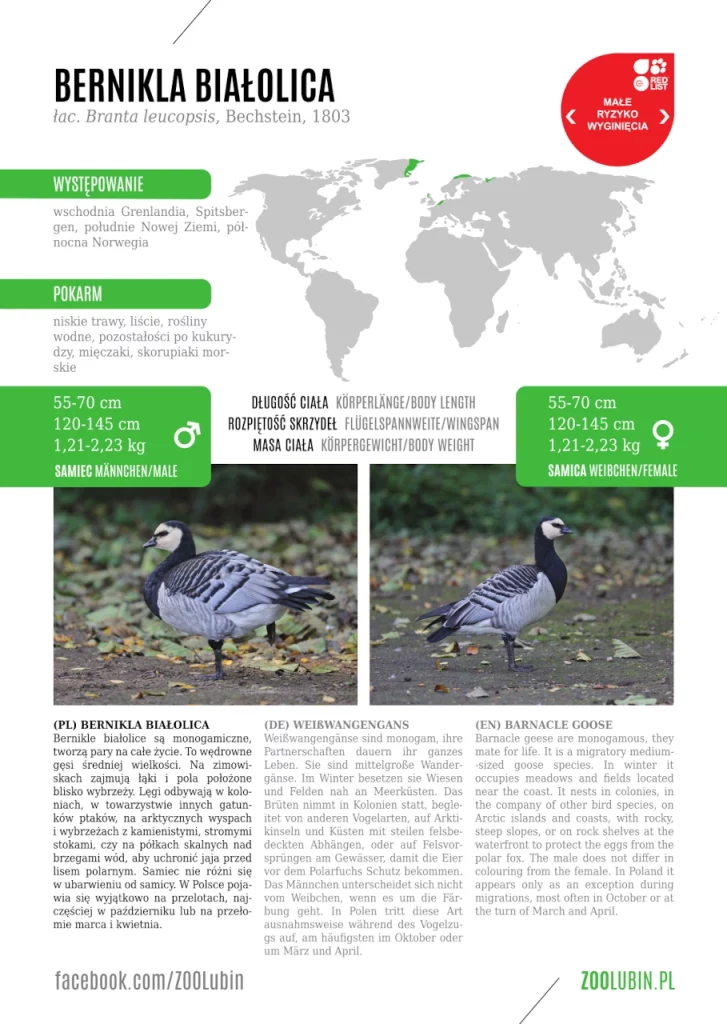
POBIERZ ETYKIETĘ GATUNKOWĄ – PLIK PDF (rozmiar 2113 KB)
Bernikla białolica (PL)
łac. Branta leucopsis, Bechstein, 1803
Bernikle białolice są monogamiczne, tworzą pary na całe życie. To wędrowne gęsi średniej wielkości. Na zimowiskach zajmują łąki i pola położone blisko wybrzeży. Lęgi odbywają w koloniach, w towarzystwie innych gatunków ptaków, na arktycznych wyspach i wybrzeżach z kamienistymi, stromymi stokami, czy na półkach skalnych nad brzegami wód, aby uchronić jaja przed lisem polarnym. Samiec nie różni się w ubarwieniu od samicy. W Polsce pojawia się wyjątkowo na przelotach, najczęściej w październiku lub na przełomie marca i kwietnia.
Występowanie: wschodnia Grenlandia, Spitsbergen, południe Nowej Ziemi, północna Norwegia
samiec / samica
Długość ciała: 55–70 cm
Rozpiętość skrzydeł: 120–145 cm
Masa ciała: 1,2–1,23 kg
Weißwangengans (DE)
łac. Branta leucopsis, Bechstein, 1803
Weißwangengänse sind monogam, sie binden sich in Paare für das ganze Leben. Es sind mittelgroße Wandergänse. Im Winter besetzen sie Wiesen und Feldern nah an Meeresküsten. Das Brüten nimmt in Kolonien statt, zusammen mit anderen Vogelarten, auf Arktik-Inseln und Küsten mit steilen felsigen Abhängen, oder auf Felsvorsprüngen am Gewässer, damit die Eier vor dem Polarfuchs geschützt werden. Das Männchen unterscheidet sich nicht vom Weibchen, wenn es um die Färbung geht. In Polen tritt diese Gans nur ausnahmsweise während des Vogelzugs auf, am häufigsten im Oktober oder gegen März und April.
Vorkommen: Ostgrönland, Spitzbergen, südlich von Nowaja Semlja, Nordnorwegen
Männchen / Weibchen
Körperlänge: 55–70 cm
Flügelspannweite: 120–145 cm
Körpermasse: 1,2–1,23 kg
Barnacle goose (EN)
łac. Branta leucopsis, Bechstein, 1803
Barnacle geese are monogamous; these migratory medium-sized geese mate for life. In winter they occupy meadows and fields located near the coast. They nest in colonies, in the company of other bird species, on Arctic islands and coasts, with rocky, steep slopes, or on rock shelves at the waterfront so that their eggs are protected from the polar fox. The male does not differ in colouring from the female. It doesn’t appear in Poland, except during migrations, most often in October or at the turn of March and April.
Distribution: eastern Greenland, Spitsbergen, south of Novaya Zemlya, northern Norway
male / female
body length: 55–70 cm
wingspan: 120–145 cm
body mass: 1,2–1,23 kg
